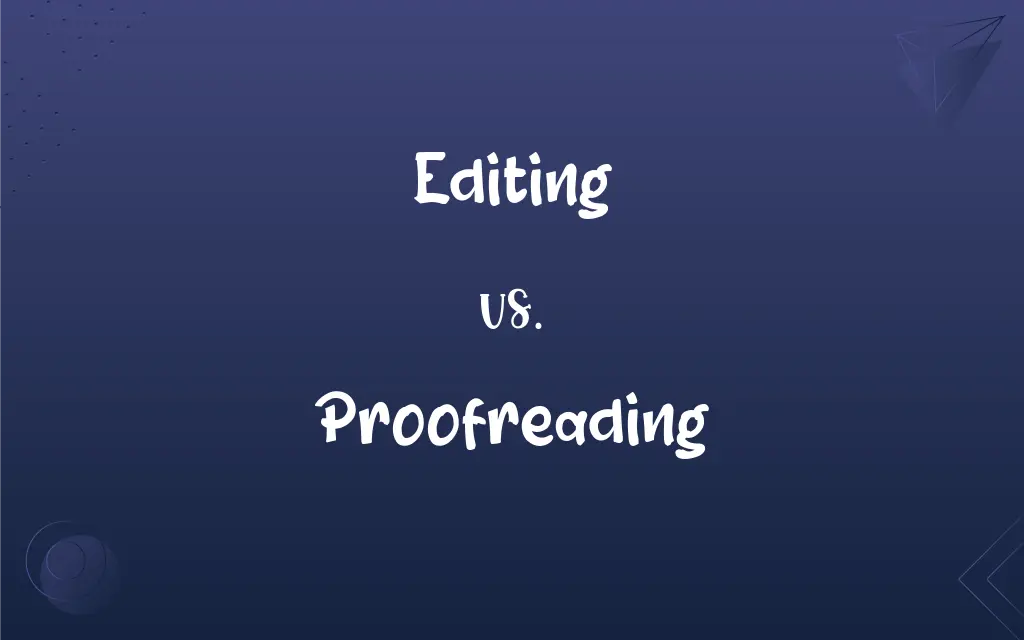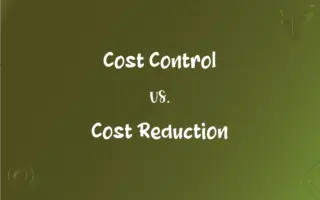Editing vs. Proofreading: What's the Difference?
Edited by Aimie Carlson || By Janet White || Updated on November 28, 2023
Editing involves improving content clarity and coherence, while proofreading focuses on correcting surface errors in grammar, punctuation, and spelling.

Key Differences
Editing delves deep into the structure, clarity, style, and flow of content, ensuring the message is clear and effective. It can involve rephrasing sentences, reordering paragraphs, or even omitting or adding entire sections to better convey the intended message. Proofreading, in contrast, comes after editing and hones in on catching typos, grammar mistakes, punctuation errors, and formatting inconsistencies.
In the realm of writing, editing is akin to refining a sculpture, chiseling away excess stone to reveal the intended form. An editor considers the audience, purpose, and voice of the text, making necessary changes to enhance its quality and readability. Proofreading, meanwhile, is like inspecting that sculpture for any minor imperfections or scratches, ensuring it's polished and presented without flaws.
When a writer has completed their draft, editing is often the next step. This process focuses on improving the overall quality of content, ensuring that ideas are presented logically, arguments are convincing, and the narrative is engaging. Following this, proofreading ensures that this carefully crafted piece is free from errors that might distract or confuse the reader.
It's crucial to recognize the distinction between editing and proofreading. While editing addresses the essence of the content, ensuring it resonates and is well-structured, proofreading is about perfection, ensuring each line is error-free. Both processes are essential to producing high-quality content.
Comparison Chart
Primary Focus
Content clarity, structure, and flow.
Surface errors like grammar, punctuation, and spelling.
ADVERTISEMENT
Depth
Involves substantial content changes.
Minor, surface-level corrections.
Stage in Writing Process
Comes before proofreading, after initial draft.
Final stage before publishing or submission.
Concerns
Audience, voice, logic, coherence.
Typos, formatting inconsistencies, punctuation errors.
Impact
Can change the message or presentation of content.
Polishes content to be error-free.
Editing and Proofreading Definitions
Editing
Enhancing style and voice.
Editing gave the novel a consistent and intriguing tone.
ADVERTISEMENT
Proofreading
Checking for grammar and spelling errors.
After proofreading, no typos remained.
Editing
Making substantial changes for improvement.
Editing transformed the draft into a publishable piece.
Proofreading
Final review before publication.
She always insists on proofreading before sending.
Editing
Addressing content logic and order.
The argument became stronger with thorough editing.
Proofreading
Inspecting content for punctuation mistakes.
Proofreading ensured all sentences ended correctly.
Editing
Refining text structure and flow.
Through editing, the essay became more persuasive.
Proofreading
Ensuring content is error-free.
Proofreading gave her confidence in her submission.
Editing
Improving content for clarity and coherence.
After editing, the article was more engaging.
Proofreading
Correcting formatting inconsistencies.
The document looked professional after proofreading.
Editing
To prepare (written material) for publication or presentation, as by correcting, revising, or adapting.
Proofreading
To read (copy or proof) in order to find errors and mark corrections.
Editing
To prepare an edition of for publication
Edit a collection of short stories.
Proofreading
To read copy or proof for purposes of error detection and correction.
Editing
To modify or adapt so as to make suitable or acceptable
Edited her remarks for presentation to a younger audience.
Proofreading
Present participle of proofread
Editing
To supervise the publication of (a newspaper or magazine, for example).
Proofreading
The act or process by which a document is proofread.
We gave the document two proofreadings, to make absolutely sure that no errors would remain.
Editing
To assemble the components of (a film or soundtrack, for example), as by cutting and splicing.
Editing
An act or instance of editing
Made several last-minute edits for reasons of space.
Editing
Present participle of edit
Editing
An act or instance of something being edited.
Editing
Putting something (as a literary work or a legislative bill) into acceptable form
FAQs
Is proofreading only about checking grammar?
No, proofreading involves checking grammar, punctuation, spelling, and formatting.
Which comes first, editing or proofreading?
Editing typically comes before proofreading.
Does editing involve checking spelling errors?
While the focus of editing is on content and structure, it can include checking for spelling.
Can editing change the original message of the content?
Editing aims to clarify and enhance the message, but it can result in significant content changes.
Can software replace human proofreading?
Software can help, but human proofreading ensures nuance and context are considered.
Do all publications require proofreading?
Ideally, yes. Proofreading ensures content is presented without errors.
How long does proofreading typically take?
It varies based on content length and complexity.
Is proofreading essential if I've already done editing?
Yes, proofreading catches surface errors missed during editing.
What's the main goal of editing?
Editing aims to improve the clarity, coherence, and overall quality of content.
Does editing involve feedback on content?
Yes, editing often includes feedback on improving content quality and structure.
Should I hire professionals for editing and proofreading?
If aiming for high-quality content, hiring professionals can be beneficial.
Can editing alter the tone of a document?
Yes, editing can refine and ensure consistency in tone.
Why is editing crucial for a document's success?
Editing ensures the content resonates, is well-structured, and effectively communicates its message.
How many rounds of editing should a document undergo?
It varies, but often a document undergoes multiple rounds of editing for refinement.
Are there different types of proofreading?
Yes, including academic, technical, and literary proofreading, each with specific focus areas.
Can editing help in reducing content length?
Yes, editing can trim unnecessary content to achieve conciseness.
Is proofreading necessary for personal documents?
For a polished presentation, even personal documents benefit from proofreading.
Are there tools to assist in proofreading?
Yes, various software tools can assist, but human review remains invaluable.
Does editing require knowledge about the subject matter?
Subject knowledge can help, but the primary focus is on content quality and structure.
How do I know if my content needs proofreading?
All content benefits from proofreading to ensure it's free from errors.
About Author
Written by
Janet WhiteJanet White has been an esteemed writer and blogger for Difference Wiki. Holding a Master's degree in Science and Medical Journalism from the prestigious Boston University, she has consistently demonstrated her expertise and passion for her field. When she's not immersed in her work, Janet relishes her time exercising, delving into a good book, and cherishing moments with friends and family.
Edited by
Aimie CarlsonAimie Carlson, holding a master's degree in English literature, is a fervent English language enthusiast. She lends her writing talents to Difference Wiki, a prominent website that specializes in comparisons, offering readers insightful analyses that both captivate and inform.






































































